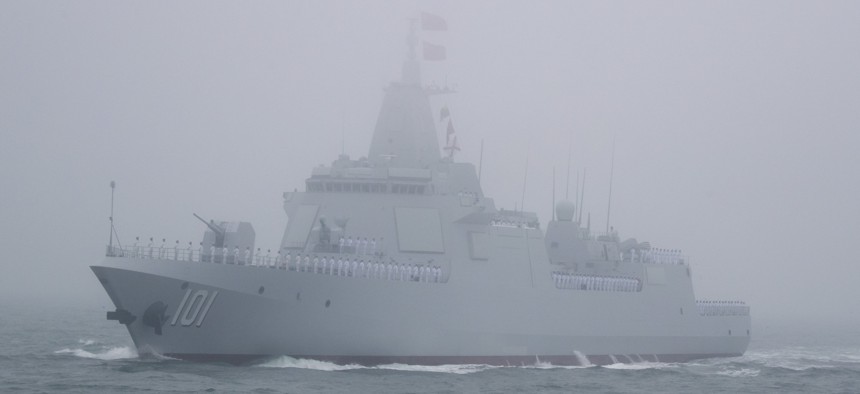
The Type 055 guided missile destroyer Nanchang of the Chinese People's Liberation Army (PLA) Navy participated in a naval parade near Qingdao, China, in 2019. MARK SCHIEFELBEIN/AFP via Getty Images
China’s Big New Warship Is Missing an Important New Weapon
When will we finally see the HQ-26 missile?
Last Christmas, the PLA Navy received a long-awaited gift when its seventh and eighth Type 055 destroyers entered service, completing delivery of its first batch of its lethal new class of warship. At roughly 13,000 tons, the Type 055s are Asia's biggest surface warships since World War II; the U.S. Navy classifies them as cruisers. However, despite impressive armaments, advanced radar systems, and other impressive capabilities, initial reporting indicates that the Type 055s appear to be missing a key weapon: the long-planned next-generation ship-to-air missile.
Ten years ago, rumors began to circulate of Chinese plans for a greatly improved version of its Russian-derived HQ-16 medium-range ship-to-air missile system. The HQ-16 was based on the Russian 9K37 Buk, whose development Moscow began back in 1972. China’s current upgraded HQ-16B dates from 2011 and has a reported maximum range of 70 km. The anticipated HQ-26 was said to be roughly equivalent to the U.S. SM-3 missile used by the Aegis ballistic missile defense system. Reportedly, it would be able to destroy short- and medium-range ballistic missiles, cruise missiles, and manned and unmanned aircraft out to 400 kilometers.
This new HQ-26 interceptor seemed tailor-made for the Type 055, which is intended for use as a missile-defense ship. Yet when the lead ship of the class, the Nanchang, was commissioned in January 2020, we saw only the old HQ-16 system, accompanied by notable silence from China’s military enthusiasts. Almost three years later, some speculate the HQ-26 still remains a year or two from deployment.
This follows similar delays with the HQ-19 SAM system. Roughly analogous to the U.S. THAAD, the HQ-19 is a two-stage missile built to hit medium-range ballistic missiles and other threats. It was expected to be operational by 2021, but there has been no official word on its prospects, much less a public unveiling.
Much like THAAD, the HQ-19 is expected to use a kinetic-kill vehicle: a non-explosive warhead that uses small engines to course-correct and collide with an enemy missile. But delays have plagued China’s efforts in this area as well. Since 2007, China has been developing mid-course interceptors, beginning with the DN-1 (also called SC-19). While it’s not clear if the DN-1 featured kinetic-kill capabilities, its successors, the DN-2 and the DN-3, appear to have them. First appearing in 2015, the DN-3 was most likely tested again in 2018, 2021, and 2022. This string of tests imply that the DN-3 is being actively developed, with China either troubleshooting faults or testing the feasibility of new features. Pentagon officials expect the DN-3 to achieve initial operating capabilities no earlier than the late 2020s.
With the HQ-26 missing, the HQ-19 still unconfirmed, and the DN-3 not through testing, Chinese ballistic missile defense efforts face a number of hurdles. While cruise missiles travel at relatively low speeds, ballistic missiles can reach speeds of 8 kilometers per second and require robust supporting architecture for missile defense systems to accurately target. Although several of China’s basic missile-defense systems claim their updated versions can handle such a challenge, their actual capabilities remain untested in battle.
Don't miss:
Yet China remains committed to building defenses against ballistic missiles, primarily to close what is viewed as a strategic gap with the mature missile-defense capabilities of Russia and the United States. For instance, in interviews dating back to 2015, Chinese strategists openly worried about China’s ability to keep pace with, much less catch up to, U.S. ballistic missile defense capabilities. Meanwhile, many of China’s most common missile systems are copied directly from Russian designs. As an example, China bought the Russian S-400 Triumf SAM system in 2014, presumably to both plug gaps in its current missile-defense capabilities, and to take apart and copy.
Another motivator may be China’s comparatively small nuclear arsenal. According to a 2015 report by the Federation of American Scientists, Chinese strategists believed that America’s new generation of missile-defense capabilities, particularly THAAD and its strong X-band radar, could shoot down enough Chinese ICBMs to undermine their deterrent effect. Given China’s relatively small nuclear force, the PLA was also concerned that future U.S. missile-defense developments would have an outsized effect on its nuclear deterrent.
Despite these strong motivators, it appears that the PLA has faced setbacks in the development of the HQ-26 ship-to-air missile system. Already past due, it’s unclear when the system will finally be deployed on PLAN destroyers. And even if the system is finally added on to the PLAN’s newest Type 055 Destroyers in the near future, it’s not clear how effective it will be against ballistic missiles.
Building a ballistic missile defense system involves solving a host of exceedingly difficult technical problems, and it’s not clear that PLA engineers are up to the challenge. Indeed, even the U.S. GMD missile defense system has been plagued with ballooning costs, technical challenges, and can still reportedly only hit targets between 25 and 50 percent of the time in scripted tests.
While the latest warships may raise the PLAN’s capabilities, it still remains unclear whether Chinese missile defense systems will be up to the challenge.
Thomas Corbett is a research analyst with BluePath Labs. His areas of focus include Chinese foreign relations, emerging technology, and international economics.



